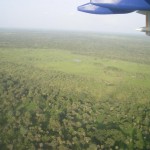19 September 2011
WASHINGTON — Cutting down forests to create cropland in the West African rainforest reduces precipitation over the rest of the forest, according to new research.
The study shows that West African rainforest deforestation reduces precipitation over neighboring trees by about 50 percent due to increased surface temperatures of croplands, which affect the formation of rain clouds.

In West African rainforests like this one in Benin, deforested areas can lead to less rainfall in neighboring forests.
(CREDIT: Doug Parker)
The authors say the findings have important implications for future decisions about land management in this region and other rainforests, including the Amazon.
“We already know from satellite observations that changes in land use can have a big impact on local weather patterns,” says Luis Garcia-Carreras with the University of Leeds School of Earth and Environment, lead author of the recent study. “Here we have been able to show why this happens.”
“Our findings suggest that it’s not just the number of trees removed that threatens the stability of the world’s rainforests. The pattern of deforestation is also important.”
Garcia-Carreras and his colleagues present their new findings in an article accepted for publication in Geophysical Research Letters, a journal of the American Geophysical Union.
The forests of West Africa and the Congo Basin are the second largest in the world after the Amazon rainforest. They serve as habitat for a vast and diverse ecosystem, and also store large amounts of carbon. When the forests are cut, carbon gets released to the atmosphere as carbon dioxide, which contributes to climate change.
For many years deforestation has been occurring widely in Africa, with tree canopies being removed for agriculture, plantations and other non-forest uses.
While the removal of trees has an immediate impact on the forest, this new study suggests that there also may be a secondary effect caused by the reduced rainfall.
“African rainforests already have the lowest rainfall of any rainforest ecosystem on Earth, which could make them particularly sensitive to changes in local weather patterns,” Garcia-Carreras says. “If rainfall is reduced even further as a result of deforestation, it could threaten the survival of the remaining forest by increasing the trees’ sensitivity to drought.”
To investigate the effects of different vegetation on locally-produced rain in West Africa, the researchers used a Met Office computer model to simulate rainfall under different land-use conditions.
In rainforests where stands had been converted to cropland, the total amount of precipitation was largely unaffected, but the rainfall was distributed differently. Rainfall was four to six times higher over warm areas (cropland) than when no deforestation has occurred, while rainfall over the remaining forest was half or less.
The difference in rainfall is caused by the temperature change between cropland and forest, which produces winds that converge over the crop area and form clouds.
And the results in West Africa could apply elsewhere, adds Doug Parker, a study co-author with the University of Leeds. “While our study only focused on a small region in Africa, it’s reasonable to suggest that this mechanism could be common in other global forests based on similar observations of rainfall in Amazonia,” he says.
“This has implications for planners in terms of how deforestation is managed. If forest must be removed to create cropland, we need to think about what are the shapes and distributions of deforestation that will be least damaging to the adjacent forests and national parks.”
The research was funded by the UK’s Natural Environment Research Council as part of the international African Monsoon Multidisciplinary Analysis (AMMA).
AGU Contact:
Kate Ramsayer, +1 (202) 777-7524, [email protected]
Leeds Contact:
Paula Gould, +0113 343 8059, [email protected]
Journalists and public information officers (PIOs) of educational and scientific institutions who have registered with AGU can download a PDF copy of this paper
Or, you may order a copy of the paper by emailing your request to Kate Ramsayer at [email protected]. Please provide your name, the name of your publication, and your phone number.
Neither this paper nor this press release are under embargo.
““How Does Local Tropical Deforestation Affect Rainfall?””
Luis Garcia-Carreras and Douglas J. Parker: Institute for Climate and Atmospheric Science, University of Leeds, Leeds, United Kingdom.
Luis Garcia-Carreras, Leeds research fellow: +44 113 3434931, [email protected]